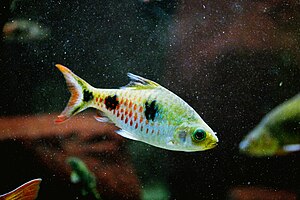Dawkinsia rubrotinctus
| Dawkinsia rubrotinctus | ||||||||||||
|---|---|---|---|---|---|---|---|---|---|---|---|---|

Dawkinsia rubrotinctus |
||||||||||||
| Systematics | ||||||||||||
|
||||||||||||
| Scientific name | ||||||||||||
| Dawkinsia rubrotinctus | ||||||||||||
| ( Jerdon , 1849) |
Dawkinsia rubrotinctus ( Syn .: Puntius rubrotinctus ) is a freshwater fish from the carp family (Cyprinidae). The species was in 1849 by the British physician, zoologist and botanist Thomas C. Jerdon as systomus rubrotinctus described later long considered synonymous with the tri-band bar ( dawkinsia arulia ) and was only in 2011 again as Puntius rubrotinctus revalidated, 2012 then by Rohan Pethiyagoda, Madhava Meegaskumbura & Kalana Maduwage assigned to the newly established genus Dawkinsia .
It occurs in southern India in the Kaveri and its tributaries in the states of Kerala , Karnataka and Tamil Nadu .
features
Dawkinsia rubrotinctus becomes 6.5 to 8 cm long and has a body typical of South Asian barbels, which is moderately elongated and laterally flattened. The head length is 28.3 to 32.8% of the standard length . The eyes are large and are closer to the tip of the snout than to the edge of the gill cover. Their diameter is 29.3 to 35.8% of the head length. The distance between the eyes corresponds to their diameter. The length of the snout is less than the diameter of the eyes. Males have a few small tubercles on their snouts that extend into the region between the eyes. The mouth is terminal, the lips thick. The maxillary reaches to the front edge of the eye. There is a small pair of barbels on the upper jaw. The barbels reach 7.3 to 13.4% of the head length.
The beginning of the dorsal fin is closer to the tip of the snout than to the base of the caudal fin, the pelvic fins start only a little behind it. The pectoral and ventral fins are short and do not reach the beginning of the anal fin. The height of the tail fin stalk is only slightly less than its length. The caudal fin is deeply forked, its ends are pointed.
- Fin formula : Dorsal : iii / 8½; Anal : iii / 5½; Pectorals : 13-14; Ventral : i / 8, caudal : 1 + 9 + 8 + 1.
- Dandruff formula : 20-22 / ½4 + 1 + 2/12.
Dawkinsia rubrotinctus has three clearly visible black spots on the sides of the body that are three scales high and two scales long. In contrast, the spots of the three-banded barb are diffuse. The distance between the dorsal fin and the hypuralia is shorter in D. rubrotinctus , as is the distance between the eyes. The number of gill pelvis rays is ten to eleven (eight in the three-banded barb). The fins are transparent.
literature
- JD Marcus Knight, K. Rema Devi & Vidyadhar Atkore: Systematic status of Systomus rubrotinctus Jerdon (Teleostei: Cyprinidae) with notes on the Puntius arulius group of fishes. Journal of Threatened Taxa (2011): 1686-1693. PDF
- ↑ Rohan Pethiyagoda, Madhava Meegaskumbura & Kalana Maduwage: A synopsis of the South Asian fishes referred to Puntius (Pisces: Cyprinidae). Ichthyol. Explor. Freshwaters, Vol. 23, No. 1, pages 69-95, 11 figs., 4 tabs., June 2012, © 2012 by Verlag Dr. Friedrich Pfeil, Munich, Germany - ISSN 0936-9902
Web links
- Dawkinsia rubrotinctus on Fishbase.org (English)